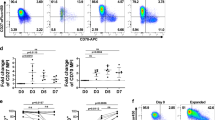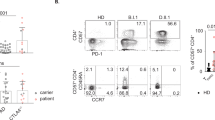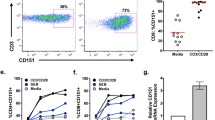Abstract
Disorders in regulatory T-cell (Treg) function can result in the breakdown of immunological self-tolerance. Thus, the identification of mechanisms controlling the activity of Treg is of great relevance. We used Treg from individuals carrying the C77G polymorphism as models to study the role of CD45 molecules in humans. C77G prevents splicing of CD45 exon A thereby leading to an aberrant expression pattern of CD45 isoforms in affected individuals. Resting and in vitro expanded/activated CD4+CD25highFoxp3+ Treg from carriers of C77G strongly expressed CD45RA isoforms whereas these isoforms were almost absent in cells from individuals with wild-type CD45. C77G Treg showed diminished upregulation of activation markers, lower phosphorylation of p56lck(Y505) and a reduced proliferative potential when stimulated with anti-TcR or anti-TcR plus CD28 mAb suggesting decreased responsiveness to activating stimuli. In addition, the capacity to suppress proliferation of conventional CD4+ T cells was impaired in C77G Treg. Furthermore, microarray studies revealed distinct gene expression patterns in Treg from C77G carriers. These data suggest that the changes in CD45 isoform combination resulting from the C77G mutation alter the responsiveness of Treg to TcR-mediated signaling. Targeting CD45 isoform expression might be a useful approach to modulate Treg function.
This is a preview of subscription content, access via your institution
Access options
Subscribe to this journal
Receive 6 digital issues and online access to articles
$119.00 per year
only $19.83 per issue
Buy this article
- Purchase on Springer Link
- Instant access to full article PDF
Prices may be subject to local taxes which are calculated during checkout






Similar content being viewed by others
References
Sakaguchi S . Regulatory T cells: key controllers of immunologic self-tolerance. Cell 2000; 101: 455–458.
Shevach EM . CD4+ CD25+ suppressor T cells: more questions than answers. Nat Rev Immunol 2002; 2: 389–400.
Hori S, Nomura T, Sakaguchi S . Control of regulatory T cell development by the transcription factor Foxp3. Science 2003; 299: 1057–1061.
Liu W, Putnam AL, Xu-Yu Z, Szot GL, Lee MR, Zhu S et al. CD127 expression inversely correlates with FoxP3 and suppressive function of human CD4+ T reg cells. J Exp Med 2006; 203: 1701–1711.
Sakaguchi S, Miyara M, Costantino CM, Hafler DA . FOXP3+ regulatory T cells in the human immune system. Nat Rev Immunol 2010; 10: 490–500.
Buckner JH . Mechanisms of impaired regulation by CD4(+)CD25(+)FOXP3(+) regulatory T cells in human autoimmune diseases. Nat Rev Immunol 2010; 10: 849–859.
Curiel TJ, Coukos G, Zou L, Alvarez X, Cheng P, Mottram P et al. Specific recruitment of regulatory T cells in ovarian carcinoma fosters immune privilege and predicts reduced survival. Nat Med 2004; 10: 942–949.
Liao G, Nayak S, Regueiro JR, Berger SB, Detre C, Romero X et al. GITR engagement preferentially enhances proliferation of functionally competent CD4+CD25+FoxP3+ regulatory T cells. Int Immunol 2010; 22: 259–270.
Hodi FS, Butler M, Oble DA, Seiden MV, Haluska FG, Kruse A et al. Immunologic and clinical effects of antibody blockade of cytotoxic T lymphocyte-associated antigen 4 in previously vaccinated cancer patients. Proc Natl Acad Sci USA 2008; 105: 3005–3010.
Levings MK, Sangregorio R, Roncarolo M . Human CD25+CD4+ T regulatory cells suppress naive and memory T cell proliferation and can be expanded in vitro without loss of function. J Exp Med 2001; 193: 1295–1301.
Hermiston ML, Xu Z, Weiss A . CD45: a critical regulator of signaling thresholds in immune cells. Annu Rev Immunol 2003; 21: 107–137.
Shimizu J, Iida R, Sato Y, Moriizumi E, Nishikawa A, Ishida Y . Cross-linking of CD45 on suppressive/regulatory T cells leads to the abrogation of their suppressive activity in vitro. J Immunol 2005; 174: 4090–4097.
Streuli M, Hall LR, Saga Y, Schlossman SF, Saito H . Differential usage of three exons generates at least five different mRNAs encoding human leukocyte common antigens. J Exp Med 1987; 166: 1548–1566.
Zikherman J, Weiss A . Alternative splicing of CD45: the tip of the iceberg. Immunity 2008; 29: 839–841.
Akbar AN, Terry L, Timms A, Beverley PC, Janossy G . Loss of CD45R and gain of UCHL1 reactivity is a feature of primed T cells. J Immunol 1988; 140: 2171–2178.
Young JL, Ramage JM, Gaston JS, Beverley PC . In vitro responses of human CD45R0brightRA- and CD45R0-RAbright T cell subsets and their relationship to memory and naive T cells. Eur J Immunol 1997; 27: 2383–2390.
Tchilian EZ, Beverley PC . Altered CD45 expression and disease. Trends Immunol 2006; 27: 146–153.
Boxall S, Stanton T, Hirai K, Ward V, Yasui T, Tahara H et al. Disease associations and altered immune function in CD45 138G variant carriers. Hum Mol Genet 2004; 13: 2377–2384.
Hennig BJ, Fry AE, Hirai K, Tahara H, Tamori A, Moller M et al. PTPRC (CD45) variation and disease association studied using single nucleotide polymorphism tagging. Tissue Antigens 2008; 71: 458–463.
Thude H, Hundrieser J, Wonigeit K, Schwinzer R . A point mutation in the human CD45 gene associated with defective splicing of exon A. Eur J Immunol 1995; 25: 2101–2106.
Lynch KW, Weiss A . A CD45 polymorphism associated with multiple sclerosis disrupts an exonic splicing silencer. J Biol Chem 2001; 276: 24341–24347.
Schwinzer R, Wonigeit K . Genetically determined lack of CD45R- T cells in healthy individuals. Evidence for a regulatory polymorphism of CD45R antigen expression. J Exp Med 1990; 171: 1803–1808.
Do HT, Baars W, Borns K, Windhagen A, Schwinzer R . The 77C→G mutation in the human CD45 (PTPRC) gene leads to increased intensity of TCR signaling in T cell lines from healthy individuals and patients with multiple sclerosis. J Immunol 2006; 176: 931–938.
Windhagen A, Sonmez D, Hornig-Do HT, Kalinowsky A, Schwinzer R . Altered CD45 isoform expression in C77G carriers influences cytokine responsiveness and adhesion properties of T cells. Clin Exp Immunol 2007; 150: 509–517.
Nyakeriga AM, Garg H, Joshi A . TCR-induced T cell activation leads to simultaneous phosphorylation at Y505 and Y394 of p56(lck) residues. Cytometry A 2012; 81: 797–805.
Hermiston ML, Zikherman J, Zhu JW . CD45, CD148, and Lyp/Pep: critical phosphatases regulating Src family kinase signaling networks in immune cells. Immunol Rev 2009; 228: 288–311.
Holmes N . CD45: all is not yet crystal clear. Immunology 2006; 117: 145–155.
Ogilvy S, Louis-Dit-Sully C, Cooper J, Cassady RL, Alexander DR, Holmes N . Either of the CD45RB and CD45RO isoforms are effective in restoring T cell, but not B cell, development and function in CD45-null mice. J Immunol 2003; 171: 1792–1800.
Kruger J, Butler JR, Cherapanov V, Dong Q, Ginzberg H, Govindarajan A et al. Deficiency of Src homology 2-containing phosphatase 1 results in abnormalities in murine neutrophil function: studies in motheaten mice. J Immunol 2000; 165: 5847–5859.
Yu WM, Wang S, Keegan AD, Williams MS, Qu CK . Abnormal Th1 cell differentiation and IFN-gamma production in T lymphocytes from motheaten viable mice mutant for Src homology 2 domain-containing protein tyrosine phosphatase-1. J Immunol 2005; 174: 1013–1019.
Carter JD, Calabrese GM, Naganuma M, Lorenz U . Deficiency of the Src homology region 2 domain-containing phosphatase 1 (SHP-1) causes enrichment of CD4+CD25+ regulatory T cells. J Immunol 2005; 174: 6627–6638.
Pan X, Yuan X, Zheng Y, Wang W, Shan J, Lin F et al. Increased CD45RA+ FoxP3(low) regulatory T cells with impaired suppressive function in patients with systemic lupus erythematosus. PLoS One 2012; 7: e34662.
Schaier M, Seissler N, Schmitt E, Meuer S, Hug F, Zeier M et al. DR(high+)CD45RA(-)-Tregs potentially affect the suppressive activity of the total Treg pool in renal transplant patients. PLoS One 2012; 7: e34208.
Booth NJ, McQuaid AJ, Sobande T, Kissane S, Agius E, Jackson SE et al. Different proliferative potential and migratory characteristics of human CD4+ regulatory T cells that express either CD45RA or CD45RO. J Immunol 2010; 184: 4317–4326.
Camirand G, Wang Y, Lu Y, Wan YY, Lin Y, Deng S et al. CD45 ligation expands Tregs by promoting interactions with DCs. J Clin Invest 2014; 124: 4603–4613.
Konig S, Probst-Kepper M, Reinl T, Jeron A, Huehn J, Schraven B et al. First insight into the kinome of human regulatory T cells. PLoS One 2012; 7: e40896.
Hanschen M, Tajima G, O'Leary F, Hoang K, Ikeda K, Lederer JA . Phospho-flow cytometry based analysis of differences in T cell receptor signaling between regulatory T cells and CD4+ T cells. J Immunol Methods 2012; 376: 1–12.
Irie-Sasaki J, Sasaki T, Matsumoto W, Opavsky A, Cheng M, Welstead G et al. CD45 is a JAK phosphatase and negatively regulates cytokine receptor signalling. Nature 2001; 409: 349–354.
Piercy J, Petrova S, Tchilian EZ, Beverley PC . CD45 negatively regulates tumour necrosis factor and interleukin-6 production in dendritic cells. Immunology 2006; 118: 250–256.
Schmidt A, Oberle N, Krammer PH . Molecular mechanisms of treg-mediated T cell suppression. Front Immunol 2012; 3: 51.
Sancho D, Gomez M, Viedma F, Esplugues E, Gordon-Alonso M, Garcia-Lopez MA et al. CD69 downregulates autoimmune reactivity through active transforming growth factor-beta production in collagen-induced arthritis. J Clin Invest 2003; 112: 872–882.
Sancho D, Gomez M, Sanchez-Madrid F . CD69 is an immunoregulatory molecule induced following activation. Trends Immunol 2005; 26: 136–140.
Bluestone JA . Regulatory T-cell therapy: is it ready for the clinic? Nat Rev Immunol 2005; 5: 343–349.
Edinger M, Hoffmann P . Regulatory T cells in stem cell transplantation: strategies and first clinical experiences. Curr Opin Immunol 2011; 23: 679–684.
Hoffmann P, Boeld TJ, Eder R, Huehn J, Floess S, Wieczorek G et al. Loss of FOXP3 expression in natural human CD4+CD25+ regulatory T cells upon repetitive in vitro stimulation. Eur J Immunol 2009; 39: 1088–1097.
Hoffmann P, Eder R, Edinger M . Polyclonal expansion of human CD4(+)CD25(+) regulatory T cells. Methods Mol Biol 2011; 677: 15–30.
Jacobsen M, Schweer D, Ziegler A, Gaber R, Schock S, Schwinzer R et al. A point mutation in PTPRC is associated with the development of multiple sclerosis. Nat Genet 2000; 26: 495–499.
Schwinzer R, Witte T, Hundrieser J, Ehlers S, Momot T, Hunzelmann N et al. Enhanced frequency of a PTPRC (CD45) exon A mutation (77C→G) in systemic sclerosis. Genes Immun 2003; 4: 168–169.
Vogel A, Strassburg CP, Manns MP . 77 C/G mutation in the tyrosine phosphatase CD45 gene and autoimmune hepatitis: evidence for a genetic link. Genes Immun 2003; 4: 79–81.
Dawes R, Hennig B, Irving W, Petrova S, Boxall S, Ward V et al. Altered CD45 expression in C77G carriers influences immune function and outcome of hepatitis C infection. J Med Genet 2006; 43: 678–684.
Schwinzer R, Schraven B, Kyas U, Meuer SC, Wonigeit K . Phenotypical and biochemical characterization of a variant CD45R expression pattern in human leukocytes. Eur J Immunol 1992; 22: 1095–1098.
Schwinzer R, Franklin RA, Domenico J, Renz H, Gelfand EW . Monoclonal antibodies directed to different epitopes in the CD3-TCR complex induce different states of competence in resting human T cells. J Immunol 1992; 148: 1322–1328.
Acknowledgements
We acknowledge the assistance of the Cell Sorting Core Facility of Hannover Medical School, which is supported in part by Braukmann-Wittenberg-Herz-Stiftung and Deutsche Forschungsgemeinschaft. We thank Dr Penelope Kay-Fedorov for her constructive comments on the manuscript. This work was supported in part by grants from the Deutsche Forschungsgemeinschaft (Schw437/2 and SFB 738).
Author information
Authors and Affiliations
Corresponding author
Ethics declarations
Competing interests
The authors declare no conflict of interest.
Rights and permissions
About this article
Cite this article
Pokoyski, C., Lienen, T., Rother, S. et al. Overexpression of CD45RA isoforms in carriers of the C77G mutation leads to hyporeactivity of CD4+CD25highFoxp3+ regulatory T cells. Genes Immun 16, 519–527 (2015). https://doi.org/10.1038/gene.2015.39
Received:
Revised:
Accepted:
Published:
Issue Date:
DOI: https://doi.org/10.1038/gene.2015.39



